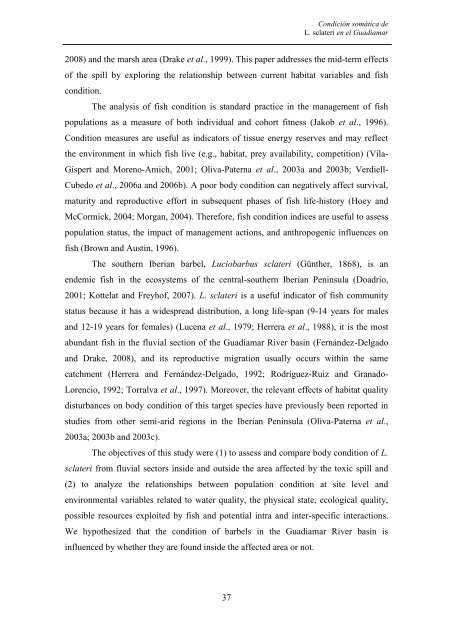las comunidades de peces del río guadiamar y el accidente minero ...
las comunidades de peces del río guadiamar y el accidente minero ...
las comunidades de peces del río guadiamar y el accidente minero ...
Create successful ePaper yourself
Turn your PDF publications into a flip-book with our unique Google optimized e-Paper software.
Condición somática <strong>de</strong><br />
L. sclateri en <strong>el</strong> Guadiamar<br />
2008) and the marsh area (Drake et al., 1999). This paper addresses the mid-term effects<br />
of the spill by exploring the r<strong>el</strong>ationship between current habitat variables and fish<br />
condition.<br />
The analysis of fish condition is standard practice in the management of fish<br />
populations as a measure of both individual and cohort fitness (Jakob et al., 1996).<br />
Condition measures are useful as indicators of tissue energy reserves and may reflect<br />
the environment in which fish live (e.g., habitat, prey availability, competition) (Vila-<br />
Gispert and Moreno-Amich, 2001; Oliva-Paterna et al., 2003a and 2003b; Verdi<strong>el</strong>l-<br />
Cubedo et al., 2006a and 2006b). A poor body condition can negativ<strong>el</strong>y affect survival,<br />
maturity and reproductive effort in subsequent phases of fish life-history (Hoey and<br />
McCormick, 2004; Morgan, 2004). Therefore, fish condition indices are useful to assess<br />
population status, the impact of management actions, and anthropogenic influences on<br />
fish (Brown and Austin, 1996).<br />
The southern Iberian barb<strong>el</strong>, Luciobarbus sclateri (Günther, 1868), is an<br />
en<strong>de</strong>mic fish in the ecosystems of the central-southern Iberian Peninsula (Doadrio,<br />
2001; Kott<strong>el</strong>at and Freyhof, 2007). L. sclateri is a useful indicator of fish community<br />
status because it has a wi<strong>de</strong>spread distribution, a long life-span (9-14 years for males<br />
and 12-19 years for females) (Lucena et al., 1979; Herrera et al., 1988), it is the most<br />
abundant fish in the fluvial section of the Guadiamar River basin (Fernán<strong>de</strong>z-D<strong>el</strong>gado<br />
and Drake, 2008), and its reproductive migration usually occurs within the same<br />
catchment (Herrera and Fernán<strong>de</strong>z-D<strong>el</strong>gado, 1992; Rodríguez-Ruiz and Granado-<br />
Lorencio, 1992; Torralva et al., 1997). Moreover, the r<strong>el</strong>evant effects of habitat quality<br />
disturbances on body condition of this target species have previously been reported in<br />
studies from other semi-arid regions in the Iberian Peninsula (Oliva-Paterna et al.,<br />
2003a; 2003b and 2003c).<br />
The objectives of this study were (1) to assess and compare body condition of L.<br />
sclateri from fluvial sectors insi<strong>de</strong> and outsi<strong>de</strong> the area affected by the toxic spill and<br />
(2) to analyze the r<strong>el</strong>ationships between population condition at site lev<strong>el</strong> and<br />
environmental variables r<strong>el</strong>ated to water quality, the physical state, ecological quality,<br />
possible resources exploited by fish and potential intra and inter-specific interactions.<br />
We hypothesized that the condition of barb<strong>el</strong>s in the Guadiamar River basin is<br />
influenced by whether they are found insi<strong>de</strong> the affected area or not.<br />
37

















